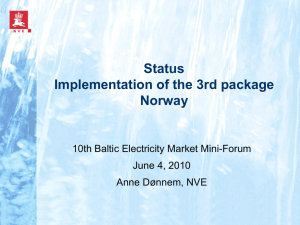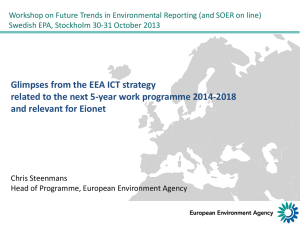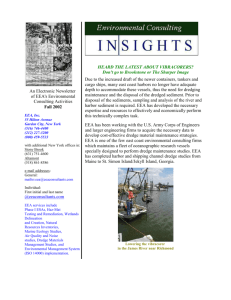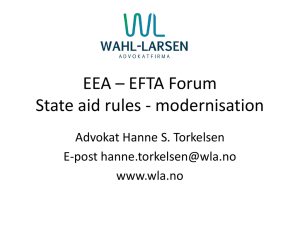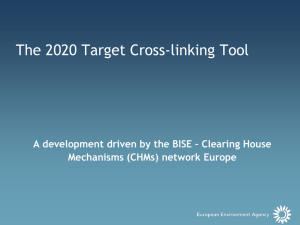Spatial data for integrated assessment of urban areas
advertisement
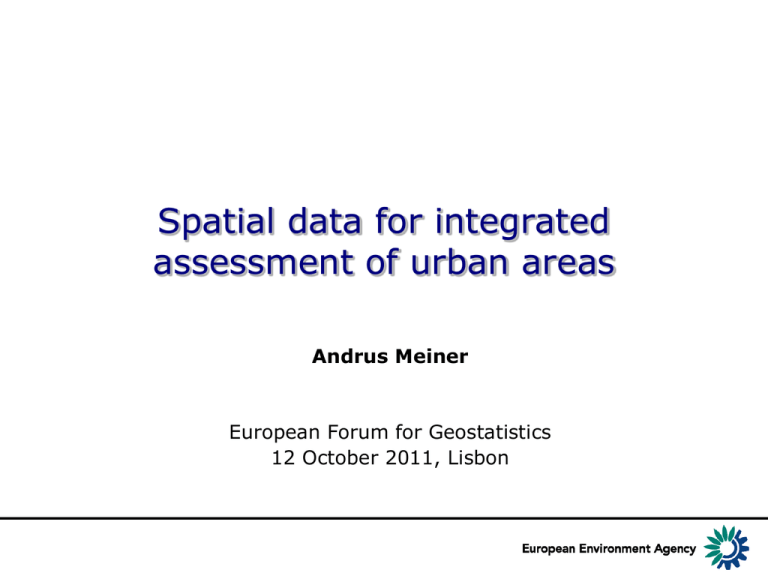
Spatial data for integrated assessment of urban areas Andrus Meiner European Forum for Geostatistics 12 October 2011, Lisbon Outline • EEA work experience with geospatial grids • Examples of urban data used in State of Environment 2010 report • Urban metabolism as a central concept of IUME - Integrated Urban Monitoring for Europe Improving our knowledge base ICT strategy towards 2013 • Enhance the EEA‘s capabilities around spatial data – • Increase EEA capacity to handle new types of data – • Spatial data sharing and integration, support to INSPIRE near real time data, satellite data, citizen observations (through mobile devices), models Strengthen role of EEA as European Environmental Data Centre and – contribute to the European Spatial Data Infrastructure Use of reference grids in the EEA • Grids for reporting and analysis ▪ • Grid-systems with Europe-wide coverage ▪ ▪ • EEA has extra-EU coverage of 32 + 7 countries Grids hierarchy for different needs e.g. 0.1, 1, 10 km Grids are used to analyse the environmental issues and variables ▪ • no primary data collection on grids need for gridded socio-economic data Increased use of grids in future ▪ data integration and assimilation Concept: Land and Ecosystem Accounting (LEAC) CORINE Land Cover: 1990-2000-2006 Next CLC 2012 The approach to generate the land accounting record for a stock Indicators for Europe Portugal based on CLC2006 and change data Net change in land cover [% of initial year 2000] Land cover 2006 [% of total] 2% 3% 3 .0 4% 6% 25% 8% 1 .0 17% 35% - 1 .0 A rtific ial areas A rable land & permanent c rops P as tures & mos aic s Fores ted land Semi-natural vegetation O pen s pac es / bare s oils Wetlands Water bodies Source: EEA, based on Corine LC 2006 Urban Growth in Europe Urban growth 115 Economic sites Residential sites Percentage increase 110 Population 105 100 95 1980 1985 1990 1995 2000 2005 IUME Integrated Urban Monitoring in Europe Combining European data sources and approaches: different urban delineations and indicators of urban flows data questions http://iume.ew.eea.europa.eu/ system Data: overview main typologies of urban delineations in Europe • • • • Urban Audit Urban Atlas GMES Land (Corine LC Class 1, HR Soil sealing) UMZ Urban Morphological Zones (built up areas • ESPON less than 200 m apart) – MUA Morphological Urban Areas – FUA Functional Urban Areas (beyond admin borders) • • MOLAND (urban areas + periurban buffers) Air quality Zones and agglomerations in relation to EU air • Noise quality thresholds urbanised areas (defined by MS) Data: types, scales, time series Eurostat Urban Audit CORINE Land Cover Noise Soil sealing Urban Atlas AirBase Water (WTP) Noise (END) European Soil DB Natura 2000 Urban coverage 10% Europe 60% Population UMZ changes Example of Barcelona 1990-2000 16 Intensity soil sealing UMZ + Urban intensity (70%) Nature need for urban green areas Climate change adaptation: heat waves Degree of soil sealing (UMZ) and predicted increase of tropical nights Green urban areas: share and access Brussels Different delineations for different purposes Static Administrative Functional Morphological Planning & Management Socio-economic Biophysical process Dynamic Regular grid - common interface for integration different delineations and other types of data Unemployment Disaggregation 2001 (Eurostat) Ref. Grid 1ha CLC 2000 (EEA) Aggregation Weighted by Population Integration Population Grid 2001 (JRC) Integration OLAP CUBE different spatial reporting units System: Basic metabolism concept Physical exchanges between the urban system and the environment Source for Urban Metabolism concept: Minx et al., 2011 Determinants of urban metabolism Basic structure of the proposed indicator system (4 types) Extending the urban metabolism concept for environmental impacts Adapted from Alberti (1996) Towards an urban metabolism database Example: Densities and GHG emissions City of Manchester Quantifying urban metabolism Downscaling data to levels of higher spatial resolution • Pragmatic, feasible indicator system – – – administrative delineations of cities as boundaries, metabolic flows as main content Additional information on urban drivers, patterns and quality • Potential of a geo-demographic approach – – – higher spatial resolution more variables (flows, patterns, lufestyles) downscaling environmental information • Urban metabolism as systemic backbone for IUME - Integrated Urban Monitoring for Europe - Synthesis - Part A – Europe and the World • ... • Urbanisation and consumption • ... - Part B – Thematic assessments • ... • Land use • Urban environment • ... - Part C – Country sketches http://www.eea.europa.eu/soer Thank you! http://www.eea.europa.eu Contact: Andrus.Meiner@eea.europa.eu The aim of IUME initiative • Provide an overview about existing urban delineation in Europe and their context, • Show the consequences of working with different delineations, and • Develop methods and tools to overcome the difficulties and show ways for data integration Future research needs Downscaling data to levels of higher spatial resolution • allowing better links between urbanisation dynamics, sprawl and their environmental impacts in more detail. • Availability of metabolic flow data for functional and morphological urban delineations, not only for administrative geographies. • Potential of geo-demographics. • A scoping of requirements for data with a higher spatial resolution across European institutions. • Review of methods for downscaling information.
